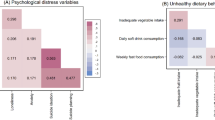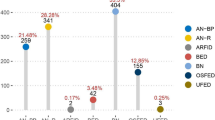Abstract
Objective: To analyse the differences in family functioning and socioeconomic status between subjects with disorders of eating behaviour and the healthy population, considering the possible relationship of these factors with the psychic characteristics of patients, with consumption of various substances, and with sexual practices.
Design: Case–control study.
Setting: ‘Puerta del Mar’ University Hospital (Andalusia, Spain).
Subjects: Conducted on a sample of 120 patients with AN and BN, and 240 controls with an identical distribution by age and sex.
Interventions: SCOFF, eating disorder inventory (EDI), Apgar family and socioeconomic questionnaires are utilised.
Results: Patients with disorders of eating behaviour present greater family dysfunctioning than controls; among cases, this difference is greater in the acute forms, but there are no differences between recent situations or crises due to previous episodes. Family dysfunction is associated with higher scores of multiple subscales of the EDI, which is corroborated on analysing each of the Apgar parameters independently. Family functioning is not associated with other variables such as breast-feeding or consumption of toxic substances. Socioeconomic status does not differentiate cases from controls, or acute situations from evolving ones, or new episodes from other crisis episodes, although differences may be found in the psychic manifestations according to social class.
Conclusions: It is confirmed that family functioning has an influence in these types of disorder, in their evolution and in the psychic characteristics of the patients, without any evidence being found of a relationship between these disorders and socioeconomic status.
This is a preview of subscription content, access via your institution
Access options
Subscribe to this journal
Receive 12 print issues and online access
$259.00 per year
only $21.58 per issue
Buy this article
- Purchase on SpringerLink
- Instant access to full article PDF
Prices may be subject to local taxes which are calculated during checkout


Similar content being viewed by others
References
Birch LL & Davison KK (2001): Family environmental factors influencing the developing behavioral controls of food intake and childhood overweight. Pediatr. Clin. N. Am. 48, 893–907.
Broadhead WE, Kaplan BH, James SA, Wagner EH, Schoenbach VJ, Grimson R, Heyden S, Tibblin G & Gehlbach SH (1983): The epidemiologic evidence for a relationship between social support and health. Am. J. Epidemiol. 117, 521–537.
Dare C & Key A (1999): Family functioning and adolescent anorexia nervosa. Br. J. Psychiatry 175, 89–90.
Fornari V, Wlodarczyk-Bisaga K, Matthews M, Sandberg D, Mandel FS & Katz JL (1999): Perception of family functioning and depressive symptomatology in individuals with anorexia nervosa or bulimia nervosa. Compr. Psychiatry 40, 434–441.
Gard MC & Freeman CP (1996): The dismantling of a myth: a review of eating disorders and socioeconomic status. Int. J. Eat. Disord. 20, 1–12.
Garner D, Olmstead M & Polivy J (1983): Development and validation of multidimensional eating disorder inventory for anorexia nervosa and bulimia. Int. J. Eat. Disord. 2, 15–34.
Herpertz-Dahlmann B, Muller B, Herpertz S, Heussen N, Hebebrand J & Remschmidt H (2001): Prospective 10-year follow-up in adolescent anorexia nervosa—course, outcome, psychiatric comorbidity, and psychosocial adaptation. J. Child Psychol. Psychiatry 42, 603–612.
Johnson JG, Cohen P, Kasen S & Brook JS (2002): Eating disorders during adolescence and the risk for physical and mental disorders during early adulthood. Arch. Gen. Psychiatry 59, 545–552.
Kendler KS (2001): Twin studies of psychiatric illness: an update. Arch. Gen. Psychiatry 58, 1005–1014.
Kuba SA & Harris DJ (2001): Eating disturbances in women of color: an exploratory study of contextual factors in the development of disordered eating in Mexican American women. Health Care Women Int. 22, 281–298.
Laliberte M, Boland FJ & Leichner P (1999): Family climates: family factors specific to disturbed eating and bulimia nervosa. J. Clin. Psychol. 55, 1021–1040.
Lemmon CR & Josephson AM (2001): Family therapy for eating disorders. Child Adolesc. Psychiatr. Clin. N. Am. 10, 519–542 viii.
McClelland L & Crisp A (2001): Anorexia nervosa and social class. Int. J. Eat. Disord. 29, 150–156.
McDermott BM, Batik M, Roberts L & Gibbon P (2002): Parent and child report of family functioning in a clinical child and adolescent eating disorders sample. Aust. N. Z. J. Psychiatry 36, 509–514.
Mijan de la Torre A & Velasco Vallejo JL (1999): Nutrición y trastornos de la conducta alimentaria (TCA): anorexia y bulimia nerviosa. Nutr. Hosp. 2, 81–91.
Morgan JF, Reid DF & Lacey JH (1999): The Scoff questionnaire: assessment of a new screening tool for eating disorders. BMJ 319, 1467–1468.
Pantano M, Grave RD, Oliosi M, Bartocci C, Todisco P & Marchi S (1997): Family backgrounds and eating disorders. Psychopathology 30, 163–169.
Pichat P (1995): DSM-IV. Manual diagnóstico y estadístico de los trastornos mentales. Barcelona, Spain: Masson SA.
Robin AL, Siegel PT, Moye AW, Gilroy M, Dennis AB & Sikand A (1999): A controlled comparison of family versus individual therapy for adolescents with anorexia nervosa. J. Am. Acad. Child Adolesc. Psychiatry 38, 1482–1489.
Rodriguez Martin A, Martinez Nieto JM, Ruiz Jimenez MA, Novalbos Ruiz JP, Vazquez MC, Fernandez YC, Gomez MA & Fernandez CC (1999): Unhealthy eating behaviour in adolescents. Eur. J. Epidemiol. 15, 643–648.
Rodriguez Martin A & Ruiz Jimenez MA (2001): Epidemiologia y prevención de los trastornos del comportamiento alimentario. In Nutrición y hormonas, eds. L. Escobar Jimenez & M. Aguilar Diosdado, pp 301–316. Madrid, Spain: Ergon.
Rogers L, Resnick MD, Mitchell JE & Blum RW (1997): The relationship between socioeconomic status and eating-disordered behaviors in a community sample of adolescent girls. Int. J. Eat. Disord. 22, 15–23.
Smilkstein G (1978): The family APGAR: a proposal for a family function test and its use by physicians. J. Fam. Pract. 6, 1231–1239.
Tsai G (2000): Eating disorders in the Far East. Eat. Weight. Disord. 5, 183–197.
Zonnevijlle-Bender MJ, van Goozen SH, Cohen-Kettenis PT, van Elburg A & van Engeland H (2002): Do adolescent anorexia nervosa patients have deficits in emotional functioning? Eur. Child Adolesc. Psychiatry 11, 38–42.
Author information
Authors and Affiliations
Corresponding author
Rights and permissions
About this article
Cite this article
Rodríguez Martín, A., Novalbos Ruiz, J., Martínez Nieto, J. et al. Epidemiological study of the influence of family and socioeconomic status in disorders of eating behaviour. Eur J Clin Nutr 58, 846–852 (2004). https://doi.org/10.1038/sj.ejcn.1601884
Received:
Revised:
Accepted:
Published:
Issue Date:
DOI: https://doi.org/10.1038/sj.ejcn.1601884
Keywords
This article is cited by
-
The association between deficiencies in paternal and maternal reflective functioning and anorexia nervosa symptomatology
Journal of Eating Disorders (2023)
-
Prospective associations of parental smoking, alcohol use, marital status, maternal satisfaction, and parental and childhood body mass index at 6.5 years with later problematic eating attitudes
Nutrition & Diabetes (2014)
-
Validation of the Finnish version of the SCOFF questionnaire among young adults aged 20 to 35 years
BMC Psychiatry (2009)
-
Socioeconomic differences in obese patients with and without eating disorders
Eating and Weight Disorders - Studies on Anorexia, Bulimia and Obesity (2007)
-
A real epidemiological study?
European Journal of Clinical Nutrition (2005)



